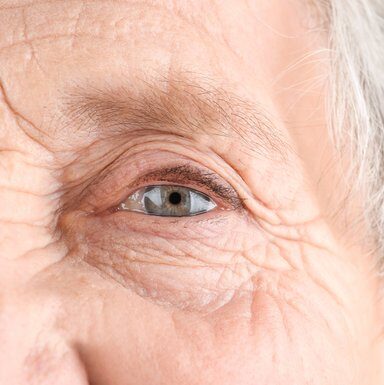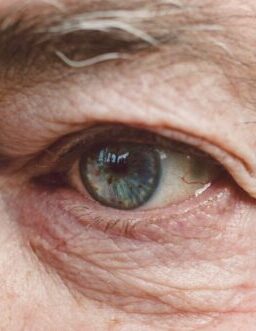Meibomian Gland Dysfunction
Learn about the importance of eyelid cleansing, the role of Meibomian Glands, and how to manage this condition. 

Have you ever wondered about the health of your eyes as you age?
One topic that often comes up is Age-related Macular Degeneration, or AMD for short. It's something that catches the interest of many, especially those over 50, as it's a leading cause of vision loss in developed countries. But don't worry; this isn't going to be a deep dive into medical jargon. Instead, let's chat about what AMD means for you and how understanding a bit about nutrition may help keep your eyes on the bright side of life1.
Imagine the eye as a camera, and the macula is its central, most crucial part of the lens that helps you see the fine details. When AMD steps in, it’s like this central part of the lens starts to wear out, affecting how you see the world—especially the straight-ahead vision you use for reading, driving, and recognizing faces. It can be a bit unsettling, knowing something like this could sneak up on you as you age, but knowledge is power, right?
Now, the catch with AMD is that it’s a bit of a sneak thief. In its early stages, it’s nearly invisible, with few symptoms. It’s only when it progresses that it makes itself known, often by blurring your central vision. But here’s where it gets interesting and a bit hopeful: while there isn’t a magic pill to prevent or cure AMD entirely, making friends with certain nutrients in your diet might help to maintain your vision1.
So, what’s on the menu for helping to keep your eyes healthy? Think colorful fruits, leafy greens, and, yes, fish. These aren’t just tasty; they’re packed with vitamins, minerals, omega-3 fatty acids, and carotenoids. Studies and experts suggest these nutrients could help slow down the progression of AMD. Let’s not forget the power of quitting smoking and a good pair of sunglasses, as both can be allies in your fight against AMD1,2.
Remember, the best approach to eye health is a proactive one. Regular check-ups with an eye specialist can catch AMD in its early stages, and a chat about how nutrition can be helpful in maintaining normal vision could be valuable. So, here’s to your health, and especially, to your eyes!
First off, AMD doesn’t have a single cause; it’s like a puzzle made up of genetic and environmental pieces. Imagine the retina in your eye as a complex, delicately balanced ecosystem. Within this ecosystem, the photoreceptors (light-sensing cells), the RPE (a layer of cells supporting the photoreceptors), and Bruch’s membrane (a layer that nourishes the retina) all play vital roles. Early signs of trouble in this ecosystem, such as the accumulation of drusen (tiny fat and protein deposits) beneath the RPE, can indicate the onset of AMD. These drusen can lead to the dysfunction and death of RPE cells, blurring your central vision over time.3

But why do these drusen form in the first place?
Several factors contribute to their buildup, including an increase in waste from the photoreceptors, impaired RPE function, oxidative damage, aging of the retinal layers, and an overactive immune system. It’s a bit like a garden where the soil quality has degraded, and the waste isn’t being cleared away properly, causing the plants (or, in this case, the photoreceptors) to suffer.3
You might be thinking, “So, is there anything I can do to keep my retinal garden flourishing?” While we can’t change our genetics, we can try to influence environmental factors. For example, a diet rich in antioxidants, omega-3 fatty acids, and certain minerals and vitamins can support eye health. This means feasting on a colorful array of fruits and vegetables, enjoying fish high in omega-3s, and considering supplements if you’re at high risk or already experiencing early signs of AMD.4,5
In summary, AMD is the result of a complex interplay between our genes and our environment, with diet playing a role in maintaining normal vision. By making mindful choices about what we eat, we can help protect our precious vision from this unwelcome guest. Remember, it’s not just about seeing the world clearly today but ensuring we can enjoy its beauty for many tomorrows to come.3
AMD centers on the macula; that’s the part of your eye’s retina responsible for sharp, straight-ahead vision. Imagine the frustration of trying to read your favorite book, recognize a friend’s face, or admire a sunset, only to find the central part of your vision is blurred or blank. This condition creeps up gradually, often without pain, making its early stages a bit of a sneak attack1,6.
In the beginning, AMD might not wave any red flags to announce its arrival. But as it progresses, AMD introduces symptoms like a loss of contrast sensitivity (imagine trying to read gray text on a white background), visual distortion (straight lines might appear wavy), and even dark spots in the center of your vision that can grow into a blind spot.1
You might find everyday activities, like reading, writing, watching TV, or recognizing faces, becoming challenging. And AMD doesn’t always play favorites; it can affect one eye or both, either simultaneously or one after the other. Sometimes, you might not even realize your vision has changed until it affects both eyes.1
Spotting AMD early can be tricky. Only a comprehensive eye exam, including a look at the back of your eye, can reveal those early signs – like drusen (small yellow deposits beneath the retina), changes in the retina’s pigment, or the thinning and deterioration of the macular region. Advanced AMD can lead to further complications, making regular check-ups with your eye doctor more than just a good idea; they’re essential.7
Being proactive about eye health can help catch AMD in its early stages, making management a bit easier. And while there’s no cure for AMD just yet, understanding its symptoms is a step toward keeping those windows to the world as clear as possible for as long as possible.
AMD is a condition that affects the macula, a critical part of your retina responsible for clear, central vision. It’s like the camera’s focus point, ensuring that what you see straight ahead is sharp and detailed.
In the early stages, AMD is not easy to detect. It’s there, but without any noticeable symptoms, making its presence known through subtle changes in your vision that you might not immediately catch. This silent onset means that many might not realize something’s off until the condition has progressed. Advanced AMD, however, is far less discreet, introducing itself with symptoms like visual distortion, where straight lines might appear wavy, or creating blind spots and blurriness right in the center of your vision. Imagine looking at a beautiful painting, only to find the middle part inexplicably smudged.1,3

So, how do eye doctors uncover this silent condition before it starts rearranging your vision’s furniture?
The key lies in comprehensive eye exams that go beyond the basics. These exams can detect AMD at its early stage. Eye specialists use a variety of sophisticated tools to take a closer look at what’s happening at the back of your eye. One such tool is the dilated eye exam, which involves using drops to widen your pupils. This allows a detailed examination of the retina, helping to spot AMD’s early signs, like drusen (tiny yellow deposits beneath the retina) or any changes in the retina’s pigment.1
But the detective work doesn’t stop there. Using fundus photography, doctors can capture detailed images of your retina, highlighting the size and extent of drusen and any pigmentary changes. Another advanced technique is Optical Coherence Tomography (OCT), a non-invasive imaging test that provides cross-sectional pictures of the retina, revealing detailed information about its layers and any potential damage from AMD. For spotting choroidal neovascularization, a condition associated with wet AMD where new, abnormal blood vessels grow under the retina, fluorescein angiography has been the gold standard. However, OCT angiography, a newer, non-invasive method, is quickly becoming a preferred option for diagnosing this aspect of AMD and monitoring its progression.1,6
In diagnosing AMD, eye specialists are using the latest technology to uncover clues hidden within your eyes. By piecing together these clues, they can determine if AMD is present, what stage it’s in, and the best course of action to protect your vision. Regular eye exams are your best defense, ensuring that if AMD decides to show up, it won’t go unnoticed.
First things first, AMD is a condition with no currently approved prevention or cure. However, hope isn’t lost. For those facing the late-stage neovascular (wet) form of AMD, treatments like anti-angiogenic agents, photodynamic therapy, and thermal laser treatments offer a beacon of light. These therapies aim to reduce the growth of abnormal blood vessels under the retina that characterize wet AMD.1
Lutein and zeaxanthin, two components from the world of carotenoids, offer additional support, especially when beta-carotene poses risks for smokers. These nutrients, found in leafy greens and other vegetables, are believed to shield the retina from damage and support visual performance. 8
Omega-3 fatty acids might play a role in AMD’s story. Found abundantly in fish like salmon and sardines, omega-3s could be like peacekeepers, reducing inflammation and supporting the health of your retinas.1,8
In navigating the AMD treatment maze, it’s clear that while we may not have a direct way out, there are several pathways to potentially slow its progression and safeguard vision.
In general, don’t hesitate to ask your pharmacist for advice if you have any eye symptoms.
On the other hand, if you experience one or more of these symptoms, you should see an eye specialist as a matter of urgency; -Moderate,-Severe pain, -Intense sensitivity to light, -Decreased vision, -Flashes of light, -Dark spots, -Sensation of a foreign object in the eye, -Trauma (injury, contusion, acid burn etc.), -Persisting or worsening symptoms despite appropriate treatment.
